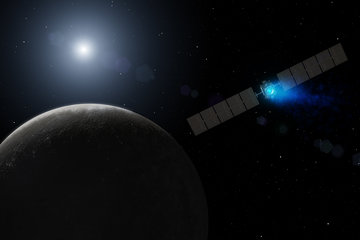New insights into star formation
The flying observatory SOFIA/GREAT was stationed at Cologne Bonn Airport until 16 March
The flying observatory SOFIA (Stratospheric Observatory For Infrared Astronomy) has successfully completed its observation flights from Cologne Bonn Airport. On board, amongst others, were scientists from the University of Cologne and the Max Planck Institute for Radio Astronomy in Bonn, who gained new insights into the formation of new stars during the observations.

SOFIA is a Boeing 747SP with a 2.7-m-diameter telescope on board, built for astronomical observations from the infrared to the submillimetre wavelength range. From 4 February to 16 March 2021, the aircraft was stationed at Cologne Bonn Airport. Typically, it embarks on its observation flights from its usual location in Palmdale/California. But SOFIA underwent maintenance for three months, carried out by Lufthansa in Hamburg. Since the coronavirus pandemic is currently making it impossible for German scientists to travel to California, SOFIA was used for an observation campaign in the night sky over Europe, conducted from Cologne Bonn Airport, before the aircraft’s return to California. This campaign has now been successfully completed.
The flying observatory is a joint project of NASA and the German Aerospace Center (Deutsches Zentrum für Luft- und Raumfahrt – DLR). SOFIA's flight altitude is more than 13 kilometres. This allows the aircraft to fly above most of the water vapour in the Earth's atmosphere, which would block infrared light at lower altitudes, thus enabling scientists to observe a wavelength range that is not accessible from Earth. Onboard SOFIA is the high-resolution receiver for far-infrared spectroscopy GREAT (German Receiver for Astronomy at Terahertz Frequencies), developed by the Max Planck Institute for Radio Astronomy in Bonn and the Institute for Astrophysics at the University of Cologne with the participation of the DLR’s Institute for Optical Sensor Systems (Berlin).

Scientists use the GREAT instrument, a spectrally high-resolution imaging spectrometer, to create a kind of chemical fingerprint of vast regions of the sky with high spatial and spectral resolution. The GREAT team not only performs measurements for its own research projects, but also collects data for other scientists.
Central to the Cologne campaign were observations made as part of the SOFIA legacy programme FEEDBACK, led by Dr Nicola Schneider at the University of Cologne’s Institute for Astrophysics and Professor Alexander Tielens at the University of Maryland. Several scientists from the MPIfR/Bonn participate in the FEEDBACK program. The goal of the programme is to systematically observe galactic massive star-forming regions. ‘First results from FEEDBACK and other recent SOFIA projects have yielded new discoveries, including bubbles of expanding gas caused by stellar winds, which can be observed clearly in the spectral line of ionized carbon (CII). This expansion causes further star formation,’ Dr Schneider explained. Furthermore, the rate at which new stars form in the Milky Way can also be determined by observing CII, providing insights into the evolution of our galaxy.
********
SOFIA is a Boeing 747SP jetliner modified to carry a 2.7-m diameter telescope. It is a joint project of the National Aeronautics and Space Administration (NASA) in the USA and the German Aerospace Center (DLR). NASA’s Ames Research Center in California’s Silicon Valley manages the SOFIA program, science and mission operations in cooperation with the Universities Space Research Association headquartered in Columbia, Maryland, and the German SOFIA Institute (DSI) at the University of Stuttgart. The aircraft is maintained and operated from NASA’s Armstrong Flight Research Center Hangar 703, in Palmdale, California.
GREAT: The German Receiver for Astronomy at Terahertz Frequencies is a high-resolution spectrometer for astronomical observations at far-infrared wavelengths (0.06-0.60 mm), operating in a wavelength regime that generally is not accessible from ground-based observatories due to absorption in the terrestrial atmosphere. The instrument’s modular design allows integration of new technological advancements on short notice. GREAT is a development by the Max Planck Institute for Radio Astronomy and the KOSMA/Universität zu Köln, in cooperation with the DLR Institute for Optical Sensor Systems. The development of GREAT is financed by the participating institutes, by the German Aerospace Center (DLR) and within the Collaborative Research Centre 956, funded by the Deutsche Forschungsgemeinschaft (DFG).













